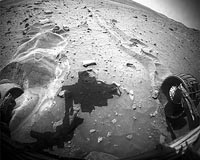 |
Paris, France (ESA) Dec 03, 2009 A series of formal presentations on the 6 medium-class candidate missions in the Cosmic Vision 2015-2025 plan was made to a large gathering of Europe's scientific community on 1 December. This meeting marks the end of the assessment phase and the start of the down-selection process. The assessment study reports are now available. The Cosmic Vision 2015-2025 plan is the current embodiment of ESA's long term scientific programme. The plan, which has been defined following consultation with the European scientific community, identifies the major scientific questions to be addressed by ESA' s future space science missions. The consultation process was followed by the selection, in October 2007, of 6 medium sized (M-class) missions for further assessment. In the intervening period each of these missions has been studied in some detail by ESA and by two independent industrial consortia, with particular emphasis on payload, cost and risk. The results of the assessment phase were presented to more than 400 representatives of the European scientific community, as well as to members of the advisory bodies of the ESA Science Programme, at a public meeting held on 1 December at the Institut Oceanographique de Paris, France.
Six diverse, medium class candidate missions Cross Scale - Performing detailed in situ multi-spacecraft exploration of universal plasma phenomena occurring in near-Earth space in order to address fundamental questions such as: how shocks accelerate and heat particles; how reconnection converts magnetic energy and how turbulence transports energy. Euclid - Mapping the geometry of the dark Universe by investigating the distance-redshift relationship and the evolution of cosmic structures through two complementary methods: baryonic acoustic oscillations measurements and weak gravitational lensing, by means of a visible/near-infrared survey of all galaxies and clusters of galaxies out to a redshift of about 2. Marco Polo - Returning a sample from a primitive Near-Earth asteroid which will allow the study of the origin and formation of the Solar System and the planets, characterisation of a Near-Earth asteroid as a representative of a primitive Solar System body, and contribute to the field of astrobiology. PLATO - Detecting and characterising exoplanetary systems of all kinds, by providing a full statistical analysis of exoplanetary systems around stars that are bright and nearby enough to allow for simultaneous and/or later detailed studies of their host stars. Solar Orbiter - Approaching the Sun as close as 48 solar radii, Solar Orbiter will view the solar atmosphere with high spatial resolution and combine this with measurements made in situ. Over the extended mission periods Solar Orbiter will deliver images and data that will cover the polar regions and the side of the Sun not visible from Earth. SPICA - Probing galaxy, star and planetary system formation, as well as the evolution of dust and gas in the interstellar medium of our own and distant galaxies, with imaging and spectroscopy spanning mid- to far-infrared wavelengths.
Next step: down-selection to 3 to 4 M-class missions Share This Article With Planet Earth
Related Links Cosmic Vision 2015-2025 plan The latest information about the Commercial Satellite Industry
 Another Stall Of Right-Rear Wheel Ends Drive
Another Stall Of Right-Rear Wheel Ends DrivePasadena CA (SPX) Dec 03, 2009 Spirit's right-rear wheel stalled again on Sol 2099 (Nov. 28, 2009) during the first step of a two-step extrication maneuver. This stall is different in some characteristics from the stall on Sol 2092 (Nov. 21). The Sol 2099 stall occurred more quickly and the inferred rotor resistance was elevated at the end of the stall. Investigation of past stall events along with these character ... read more |
|
| The content herein, unless otherwise known to be public domain, are Copyright 1995-2009 - SpaceDaily. AFP and UPI Wire Stories are copyright Agence France-Presse and United Press International. ESA Portal Reports are copyright European Space Agency. All NASA sourced material is public domain. Additional copyrights may apply in whole or part to other bona fide parties. Advertising does not imply endorsement,agreement or approval of any opinions, statements or information provided by SpaceDaily on any Web page published or hosted by SpaceDaily. Privacy Statement |